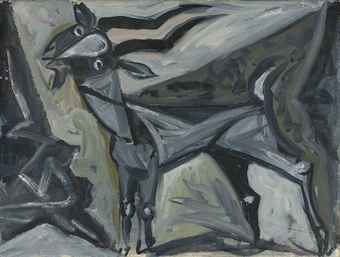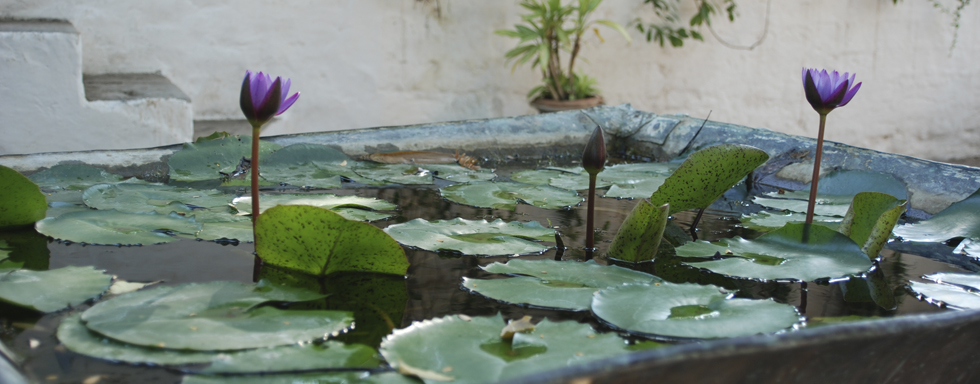 | ||
| Source: Your Paintings BBC. © estate of John Craxton 2013. All rights reserved, DACS photo credit: Bristol Museum and Art Gallery |
The John Craxton exhibition at the Fitzwilliam Museum (I recommended it here) has generated quite a few reviews!
Here's my selection:
Reviews in personal blogs
Juliet Miller says:
"Craxton is an interesting painter who has not been very widely known."
One of her favourites: Four Figures in a Mountain Landscape
"It evokes Greek mythology but is painted with a very English hand. [...] I wanted to be in this rough, rocky landscape myself or even live the life depicted."
Conclusion:
"If you are interested in British painters of the pre- and post war period this view into the internal world of a private yet exuberant painter is certainly worth the trip."

Joseph Scissorhands says:
"I had seen two of his paintings at Tate Britain fairly recently and was curious to see more."
One of his favourites: Four Figures in a Landscape
"which shows his [Craxton's] mastery of composition, line and tone."
Conclusion:
"I enjoyed this show as it was a bright blast of Mediterranean sunshine on a wintry Cambridge morning."
"Craxton is an interesting painter who has not been very widely known."
One of her favourites: Four Figures in a Mountain Landscape
"It evokes Greek mythology but is painted with a very English hand. [...] I wanted to be in this rough, rocky landscape myself or even live the life depicted."
Conclusion:
"If you are interested in British painters of the pre- and post war period this view into the internal world of a private yet exuberant painter is certainly worth the trip."
Joseph Scissorhands

Joseph Scissorhands says:
"I had seen two of his paintings at Tate Britain fairly recently and was curious to see more."
One of his favourites: Four Figures in a Landscape
"which shows his [Craxton's] mastery of composition, line and tone."
Conclusion:
"I enjoyed this show as it was a bright blast of Mediterranean sunshine on a wintry Cambridge morning."
Chris Priestley

Chris Priestley says:
"I like the exhibitions at the Fitzwilliam. They tend to be small and a little bit eclectic."
One of his favourites:
"my favourite being a small picture - a tempera I think - of a goat."
Conclusion:
"I don't know what I make of John Craxton's work. [...] Some of his work I really like, but there is a lot I really don't like. His influences are possibly too readable." |
| Source: Your Paintings BBC. © estate of John Craxton 2013. All rights reserved, DACS photo credit: Tate |
Reviews in the national pres
Reviews in the national pres
Richard Dorment says:
"John Craxton, who died in 2009, was the last Romantic. Or rather neo-Romantic."
"John Craxton, who died in 2009, was the last Romantic. Or rather neo-Romantic."
One of his favourites:
Doesn't cite a favourite picture. Still Life with Cat and Child does "amount to pastiche."
Doesn't cite a favourite picture. Still Life with Cat and Child does "amount to pastiche."
Conclusion:
"He wasn’t an artist of the first rank but he was inimitable. This show is just the right scale and it comes with a beautifully illustrated book ... by his friend Ian Collins."
"He wasn’t an artist of the first rank but he was inimitable. This show is just the right scale and it comes with a beautifully illustrated book ... by his friend Ian Collins."

Andrew Lambirth says:
"[Craxton's] finest paintings lead the viewer into a visionary universe of colour and light and bounding structures, whose taut rhythms release a feeling of euphoria in the beholder and beguile the imagination with intimations of visual splendour."
One of his favourites: Landscape, Malevizi, Crete
"...the finest example I’ve seen in recent years is ‘Landscape, Malevizi, Crete’ (1952), a superb balance of pattern and description. A painting of that quality and joyous, seemingly effortless execution, a perfect blending of linearity and colour, is missing from the Fitzwilliam."
"...the finest example I’ve seen in recent years is ‘Landscape, Malevizi, Crete’ (1952), a superb balance of pattern and description. A painting of that quality and joyous, seemingly effortless execution, a perfect blending of linearity and colour, is missing from the Fitzwilliam."
Conclusion:
"Craxton is actually quite a lot better than the sum of the Fitzwilliam show, which offers only a very partial view of this complex artist."

Michael Prodger says:
" 'A World of Private Mystery: John Craxton RA (1922-2009)', a small but choice exhibition at the Fitzwilliam, is an overview and reminder of the career of this unfashionably joyous painter."
One of his favourites:
"One of his most unaffectedly pleasurable paintings is a colour-saturated image of three sailors eating a meal of prawns, squid, sardines and salad that is mouth-watering in every sense."
Conclusion:
"A man of great charm, Craxton became friends with Patrick Leigh Fermor in Greece and it is through his drawings for the scholar-traveller’s dust jackets that he is now best known."
 |
| Source: Christie's. John Craxton, Grey Goat. |
Reviews in blogs and the national press: a comparison
• Blogs are less wordy. Sentences are shorter. Blog authors adapt their prose to the way reader quickly scan the screen.• Blogs are more personal. Blog authors state personal preferences. They tell stories about how and why they visited the exhibition. One author said their friend had wanted to see it; another commented on the weather.
• Reviews for the national press are longer. They include quotations (from the artist or the artist's friends). They name influences. They offer stylistic categories ('neo-Romantic', 'Arcadian').
• Reviewers for the national press sometimes assert their own credentials and authority. The reviewer for The Spectator, for example, explained that he had himself curated two exhibitions. Perhaps they feel the need to do this because they are getting paid?
• Reviews for the national press can be a bit pretentious and formalist. Phrases like taut rhythms or colour-saturated don't tend to appear in blog reviews.
• Reviewers for the national press make more of the artist's reputation and the question of artistic quality: not an artist of the first rank or unfashionably joyous or quite a lot better than the sum of the Fitzwilliam show.
What type of review do you prefer? Click on the little pencil below (where it says 'no comment' or 'comments') and leave a comment.
Also: judge for yourself and visit the exhibition. John Craxton, Fitzwilliam, ends 21 April.


No comments:
Post a Comment